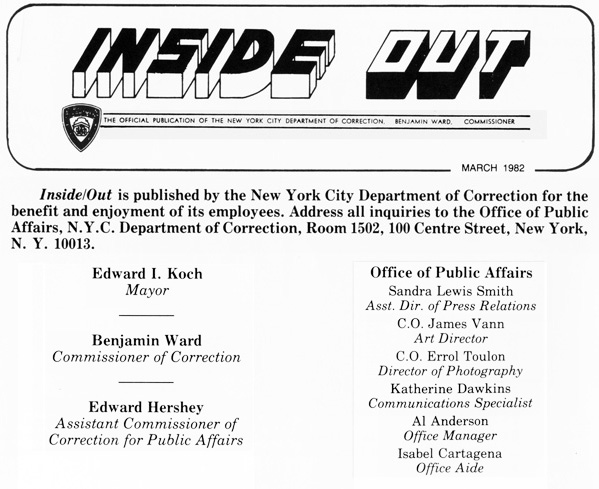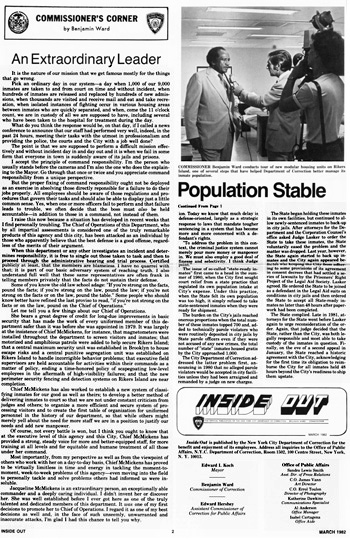In a "Commissioner's Corner" column entitled "An Extraordinary Leader," he took on criticism directed at Chief of Operations Jacqueline McMickens, reputedly from union sources, in the wake of investigatory and disciplinary actions that followed one or more unspecified major foul-ups among DOC staffers. One such incident may have been that cited in the newsletter's Page 1 "Inspection Division Formed" story: ". . . . nine inmates fled through a salleyport at the Brooklyn State Supreme Court Building in January." The staff of Inside Out included Errol D. Toulon, then a C.O. who served as its photographer. In due course, he would rise through the ranks to become Correction Academy Deputy Warden during the 1990s. In the summer of 2010, Toulon, a Monroe College professor, made available to this website a copy of the March 1982 issue of Inside Out. From that issue copy, the NYCHS webmaster has created this eight-page web presentation of extracted images and texts. This web page's images and texts were extracted from that newsletter issue's Page 2 .  Pick an ordinary day in our system—a day when 1,000 of our 9,000 inmates are taken to and from court on time and without incident, when hundreds of inmates are released and replaced by hundreds of new admissions, when thousands are visited and receive mail and eat and take recreation, when isolated instances of fighting occur in various housing areas between inmates who are quickly separated, and when, come the 11 o’clock count, we are in custody of all we are supposed to have, including several who have been taken to the hospital for treatment during the day. What do you think the response would be, on that day, if I called a news conference to announce that our staff had performed very well, indeed, in the past 24 hours, meeting their tasks with the utmost in professionalism and providing the police, the courts and the City with a job well done? The point is that we are supposed to perform a difficult mission effectively and without incident day in and day out and it is when we fail in some form that everyone in town is suddenly aware of its jails and prisons. I accept the princip1e of command responsibility. I’m the person who usually stands before the cameras and I’m also the one who does the explaining to the Mayor. Go through that once or twice and you appreciate command responsibility from a unique perspective. But the proper fixing of command responsibility ought not be deployed as an exercise in absolving those directly reponsible for a failure to do their jobs properly. All employees should be aware of those regulations and procedures that govern their tasks and should also be able to display just a little common sense. Yes, when one or more officers fail to perform and that failure leads to trouble, we often decide that the boss must also be held accountable—in addition to those in a command, not instead of them. I raise this now because a situation has developed in recent weeks that I find personally troubling. The Chief of Operations of this Department, who by all impartial assessments is considered one of the truly remarkable products of this agency and this city, has been attacked as an individual by those who apparently believe that the best defense is a good offense, regardless of the merits of their argument. When this department or any other investigates an incident and determines responsibility, it is free to single out those taken to task and then to proceed through the administrative hearing and trial process. Certified bargaining agents don't have that luxury to pick and choose. As a practical matter, and in most cases as a legal one, they must defend to the best of their ability all the members so accused. Consequently, they must take the position, publicly at least, that the members are blameless. I have no quarrel with that; it is part of our basic adversary system of reaching truth. I also understand full well that these same representatives are often frank in telling members privately that the facts do not sustain their defense. Some of you know the old law school adage: “If you’re strong on the facts, pound the facts; if you’re strong on the law, pound the law; if you’re not strong on the facts or on the law, pound the table.” Some people who should know better have refined the last proviso to read, “if you’re not strong on the facts or on the law, pound on the Chief of Operations." Let me tell you a few things about our Chief of Operations. She bears a great degree of credit for long-due improvements in basic security that has made the work of every uniformed member of this department safer than it was before she was appointed in 1979. It was largely at the insistence of Chief McMickens, for instance, that magnetometers were installed throughout the department to screen visitors and inmates; that motorized and amphibious patrols were added to help secure Rikers Island; that a central maximum security unit was established in Brooklyn to house escape risks and a central punitive segregation unit was established on Rikers Island to handle incorrigible behavior problems; that executive field supervisors are held accountable for activities within their commands as a matter of policy, ending a time-honored policy of scapegoating low-level employees in the aftermath of high-visibility failures; and that the new perimeter security fencing and detection systems on Rikers Island are near completion. Chief McMickens has also worked to establish a new system of classifying inmates for our good as well as theirs; to develop a better method of delivering inmates to court so that we are not under constant criticism from judges and others; to organize a more efficient and secure system of processing visitors and to create the first table of organization for uniformed personnel in the history of our department, so that while others might merely yell about the need for more staff we are in a position to justify our needs and add new manpower. Of course, not every battle is won, but I think you ought to know that at the executive level of this agency and this City, Chief McMickens has provided a strong, steady voice for more and better-equipped staff, for more training at all levels and for equitable and humane treatment of all those under her command. Most importantly, from my perspective as well as from the viewpoint of others who work with her on a day-to-day basis, Chief McMickens has proved to be virtually limitless in time and energy in tackling the moment-to- moment, week-to-week problems of this agency—even moving into the field to personally tackle and solve problems others had informed us were insoluble. Jacqueline McMickens is an extraordinary person, an exceptionally able commander and a deeply caring individual. I didn’t invent her or discover her. She was well established before I ever got here as one of the truly talented and dedicated members of this department. It was one of my first decisions to promote her to Chief of Operations. I regard it as one of my best decisions as well and, in the face of such unseemly, unwarranted and inaccurate attacks, I’m glad 1 had this chance to tell you why. 
Also visit on this site:
|


